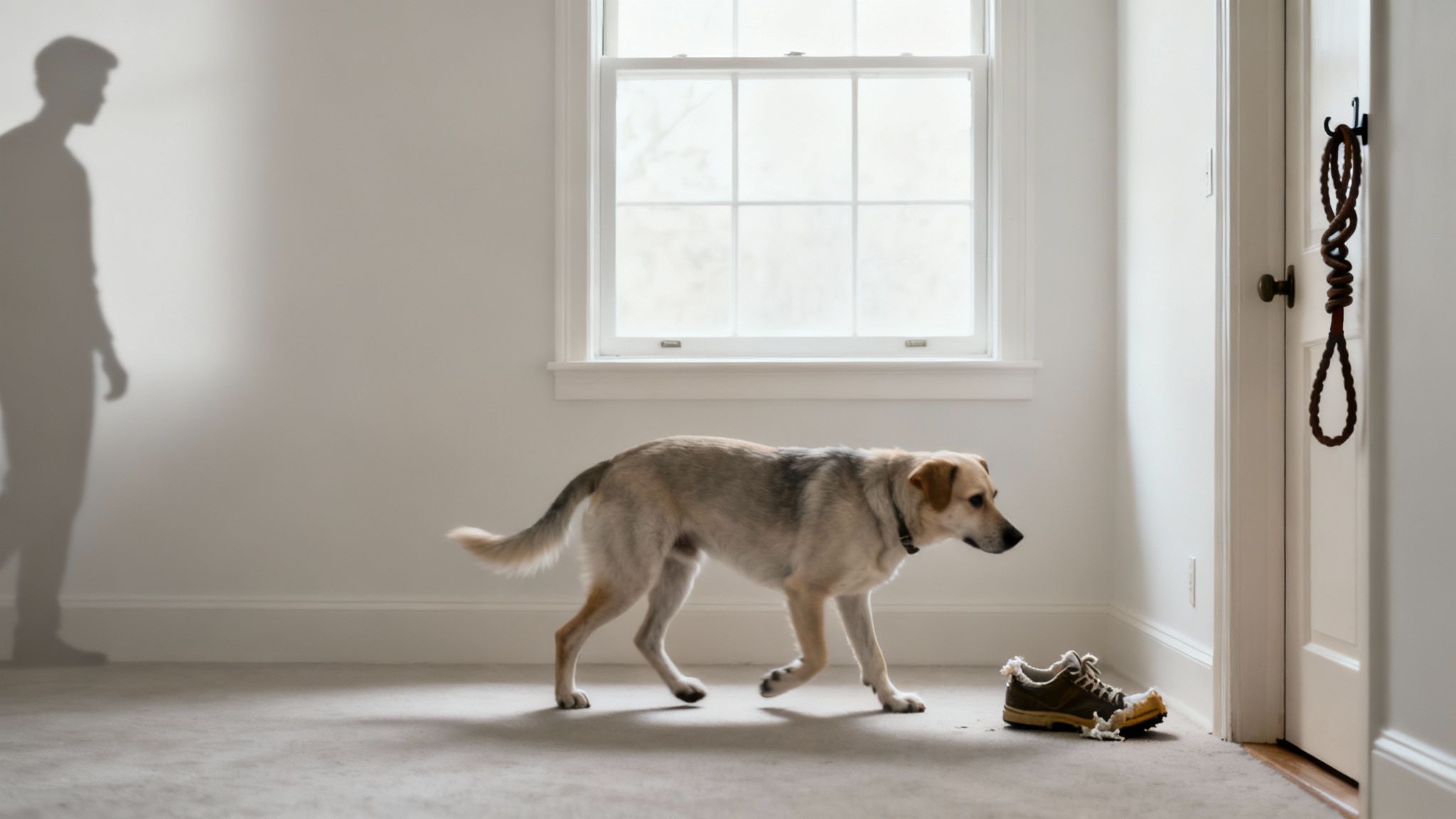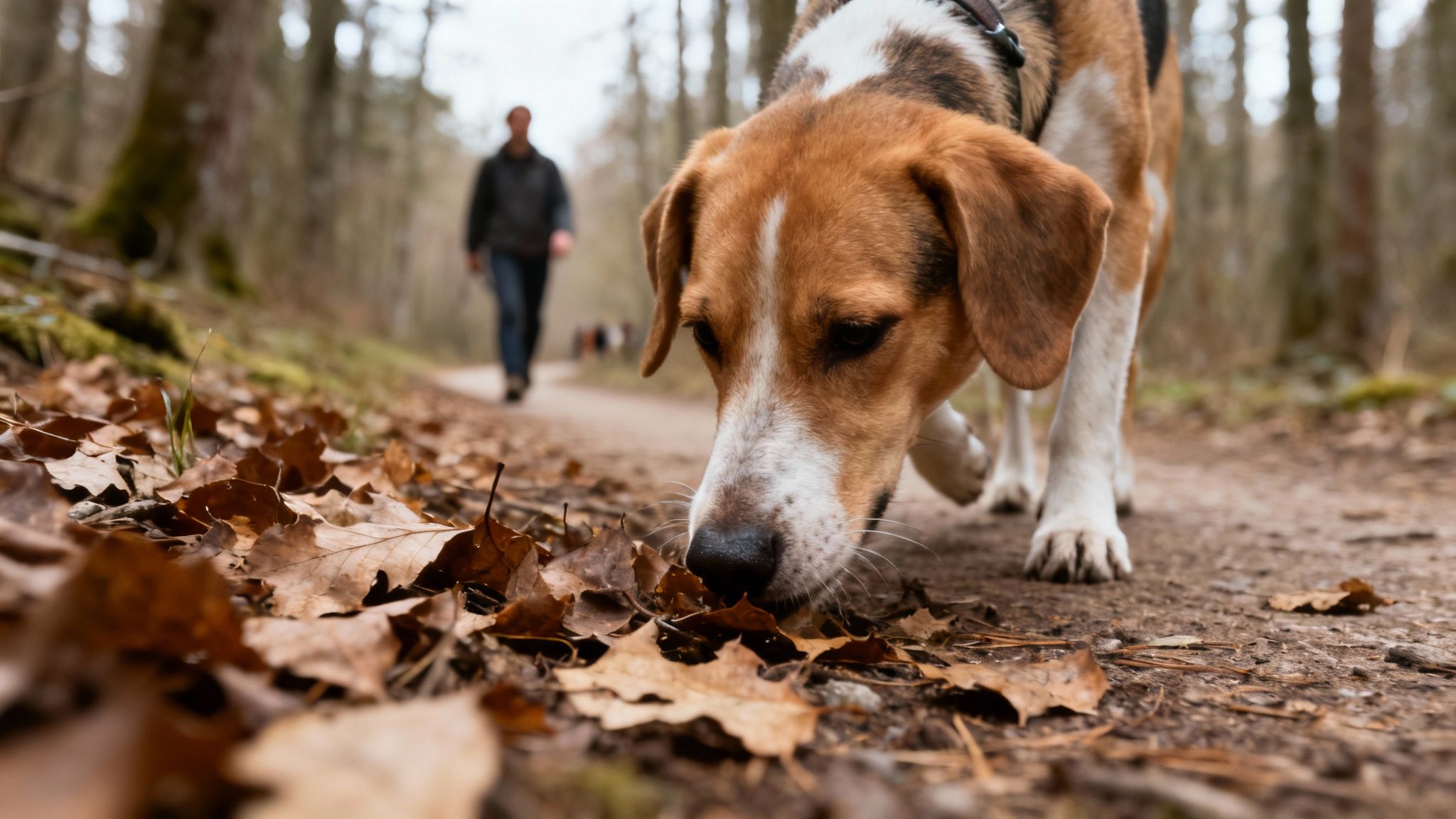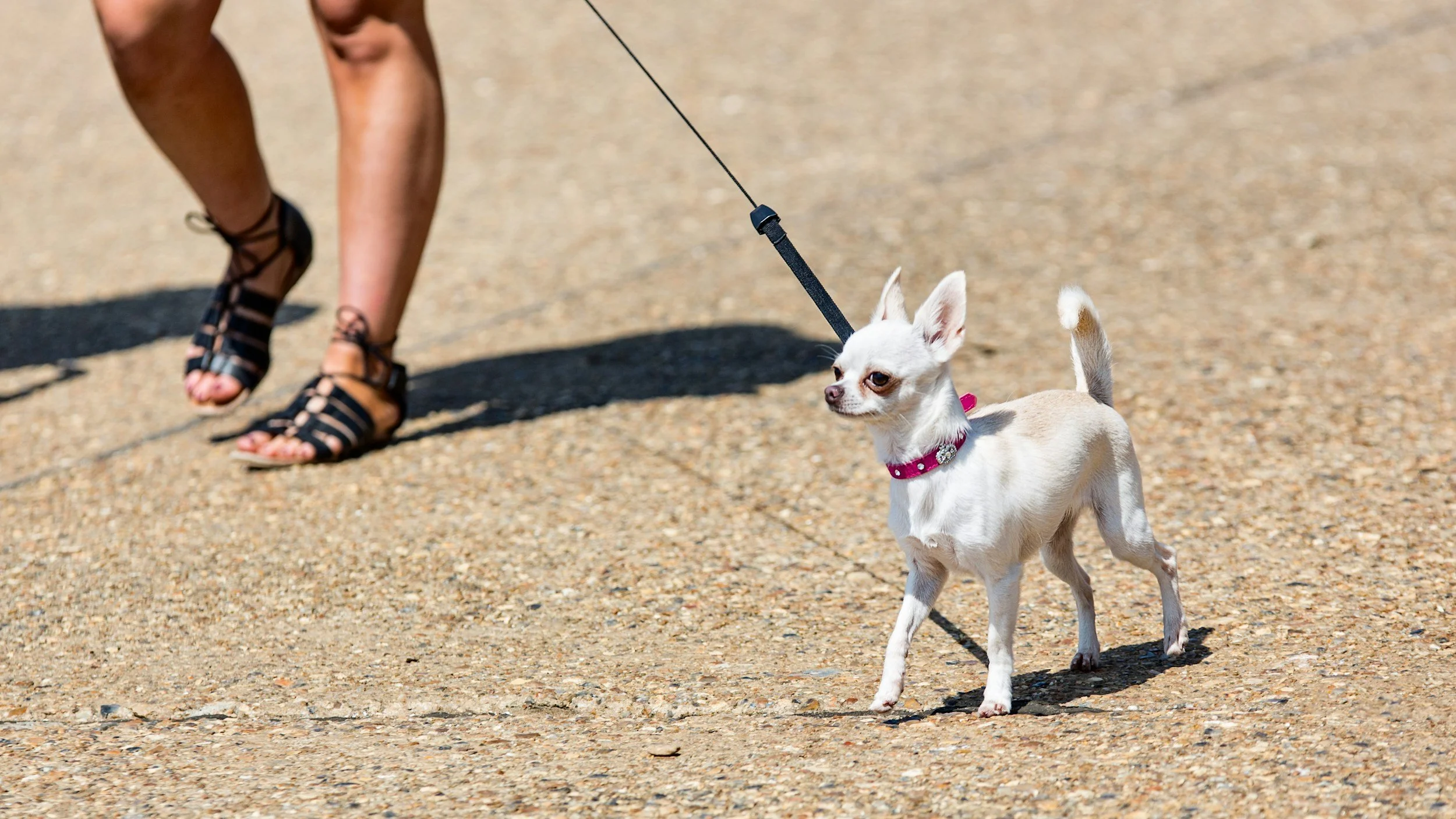How Often Should Dogs Be Walked? A Complete Guide
Table of Contents
Key Takeaways
The Baseline: Most adult dogs thrive on 2-3 walks per day, totaling at least 30-60 minutes.
Listen to Your Dog: A dog's breed, age, size, health, and personality are the best guides for customizing their walking schedule.
It's More Than Exercise: Walks are crucial for mental stimulation, allowing dogs to sniff, explore, and connect with their natural instincts.
Read the Signs: Restlessness or destructive behavior can mean your dog needs more activity, while soreness or reluctance might signal a need for shorter, gentler walks.
Enrich the Experience: Incorporate scent work, varied trails, and mindful presence to make every walk a soulful adventure for both of you.
Tuning Into Your Dog's Unique Needs
Here at Wild Pack, after countless strolls and pack walk adventures, we frequently hear the question, "Just how often should I take my furry friend for a walk?"
While a great starting point for most adult dogs is 2-3 walks per day, there's no single magic number. This simple rhythm does more than provide potty breaks—it gives your dog a chance to explore and reconnect with their wild instincts.
A walk is more than a bathroom break or a way to burn off energy. For a dog, it’s a full-on sensory journey. It’s their chance to read the stories left behind in every scent on the trail and feel the earth beneath their paws.
When we shift our mindset from "taking the dog out" to "exploring the world together," the experience transforms. The goal isn't just to cover a certain distance, but to provide mental nourishment. Every sniff, every pause to investigate a sound—that's your dog tapping into the ancient wisdom inside them.
This daily practice becomes a shared ritual, grounding both you and your dog in nature’s rhythm. It’s an opportunity to simply be present and connect.
Breed and Energy Blueprint
A dog’s breed provides insight into their ancestral background, indicating their natural energy levels. Consider a Border Collie, bred for lengthy days of herding sheep. They have a strong need for activity and purpose. For them, a daily walk should be more than a casual stroll; they require invigorating hikes or engaging play to satisfy this innate drive.
In contrast, the Basset Hound, bred for endurance rather than speed, excels at tracking scents with their nose to the ground. Their ideal walk might be slower and focused on sniffing, allowing them to engage with the world through their exceptional sense of smell. Understanding this ancestral background helps us respect their natural tendencies.
Additionally, while considering the number of walks, the total time spent walking is crucial. Smaller dogs generally do not require as many miles as larger dogs, so factoring in their size is essential when planning their exercise.
The Rhythm of Age
Just like us, a dog’s walking needs change throughout their life, mirroring the natural cycles of growth and rest.
Puppies are little balls of energy, but they also have tiny bladders and developing joints. They thrive on short, frequent walks—think five to ten minutes, several times a day. These outings are crucial for potty training and safely introducing them to the world’s amazing sights and smells. You can get more guidance by reading about how to train a puppy at home.
Adult dogs are in their prime and generally need the most consistent exercise. This is where that 2-3 walks per day guideline really holds true, giving them the physical and mental stimulation they need to stay happy and balanced.
Senior dogs might slow down, but their need for gentle movement and sniffing adventures remains strong. Shorter, slower walks on softer surfaces can help keep their joints mobile and their minds sharp, honoring their wisdom and grace.
Health and Personality Considerations
A dog's physical health directly impacts how much they can enjoy a walk. Conditions like arthritis, hip dysplasia, or heart issues require a gentler approach. And for brachycephalic (flat-faced) breeds like Pugs or French Bulldogs, breathing can be a challenge, especially in warm weather. Their walks should be brief and scheduled during cooler parts of the day.
A surprising number of dogs aren't walked as often as they should be. A 2015 review found that about 36% of owners either don't walk their dogs or do so only occasionally, with average daily walk times being as low as 17 minutes. You can read the full research about these dog walking habits for more details.
When in doubt, always chat with your vet to create a safe and supportive walking plan, especially if your dog has any health concerns.
Signs Your Dog Needs a Different Walking Routine

Our dogs are always talking to us, though not always with barks and whines. Their behavior is a rich language all its own—messages that give us a peek into their world. When their walking routine isn't quite hitting the mark, they'll let you know.
Learning to read these signs isn't about judging behavior. It’s about listening with curiosity and compassion. Think of it as tuning into their feedback, letting you mindfully adjust the routine and strengthen your bond.
Cues for More Adventure
When a dog's needs for physical and mental exercise aren't being met, they'll often find their own outlets for that pent-up energy. This is their wild spirit trying to break through the confines of a quiet day.
You might start noticing an uptick in behaviors like these:
Restlessness and Pacing: Does your dog seem like they just can't settle down? Wandering from room to room as if they're searching for something to do is often a sign they have energy to burn.
Destructive Habits: Finding your favorite shoes chewed up isn't just mischief. It can be a dog's attempt to self-soothe or create their own "job" when they're bored.
Excessive Barking or Whining: Sometimes, a dog that barks at every leaf falling outside is simply saying, "I'm bored! Let's go see what's happening out there!"
Leash Pulling and Frustration: While this can be a training issue, intense pulling might also signal that walks are too short or infrequent, making them overly exciting.
Signs of a Slower Pace
It’s just as important to spot when your dog might be getting too much of a good thing. Pushing them too hard can strain their body and dampen their spirit. This is especially true for senior dogs or those with health conditions who need their activity to be restorative, not draining.
Keep an eye out for these more subtle cues:
Persistent Soreness: If you notice your dog is extra stiff after a nap or lagging behind on walks, it could mean their muscles and joints are crying out for more recovery time.
Exhaustion After Walks: It's normal for a pup to be tired after a good walk, but if they seem completely wiped out or lethargic for hours, the walk might have been too intense.
Reluctance to Go: If your once-enthusiastic walking buddy suddenly hesitates or seems stressed when you grab the leash, they could be associating walks with pain or exhaustion.
Beyond the Basic Walk: Enriching Your Dog's World

A walk can be so much more than a quick potty break. When we see it as a sensory adventure, we open up a new world of enrichment for our dogs, letting them tap into their wild, instinctual selves. It’s not just about moving their paws; it’s about waking up their minds.
The greatest gift we can give our dogs on a walk is letting them follow their nose. Every sniff tells a story, and when we give them the freedom to explore scents, we’re honoring their most powerful sense. This is deeply fulfilling and often tires them out more than a fast-paced power walk.
Awakening Their Instincts
Taking it a step beyond the simple neighborhood stroll can transform exercise into a soulful practice of connection. There are a few activities you can weave into your routine to satisfy your dog's innate drives.
Scent Work and Nosework: This is the ultimate way to celebrate your dog’s natural talents. Simple games that encourage them to find hidden treats can awaken their hunting drive in a fun, low-impact way. It’s an incredible confidence-booster and provides fantastic mental stimulation.
Pack Walks: Walking with other well-matched dogs taps right into their social nature. It teaches them how to coexist calmly and fulfills their instinct to move as a group, creating a sense of community.
Varied Trail Hikes: There’s nothing like getting out into nature. Exploring different trails engages all their senses—new smells, new sights, and different textures under their paws provide a rich tapestry of information for their brains to process.
Want to learn how to turn every walk into a sensory adventure? Our free nosework guide shows you how to awaken your dog's natural instincts, one sniff at a time.
👉 Download your free guide here!
The Power of Play and Exploration
Structured play is another beautiful way to meet your dog’s needs. A good game of fetch allows them to engage in natural behaviors like chasing, all within a safe context with you. This is also where you can get creative with a variety of dog mental stimulation games to keep their minds sharp.
A truly enriching walk strikes a balance between physical movement and mental engagement. Research shows that while many owners aim for about 31 minutes per walk, a surprising number don't walk their dogs daily. By making each outing a chance for enrichment, we make every moment count.
Don't forget their well-being extends into the home, too. A huge part of this is maintaining a clean home for your furry friend to keep allergens down. A healthy environment supports a healthy mind and body, giving them the perfect space to restore after their wild adventures.
Practical Tips for Safe and Soulful Walks
Knowing how often to walk your dog is just the first piece of the puzzle. The real magic happens when you turn each walk into a safe, grounding, and joyful ritual. The quality of your time together matters just as much as the quantity.
By being mindful and prepared, we can elevate a simple walk into a shared experience that nourishes both of you. It's about tuning into the world around you. This is your time to be fully present with your dog, noticing the little things they find fascinating and feeling the rhythm of your steps syncing up. You’re moving together as a tiny, unified pack. Watch this video on tips for integrating mindfulness into your walks.
Gearing Up for the Trail
Having the right gear makes all the difference, keeping your dog comfortable and safe. A well-fitting harness, for instance, is often a better choice than a collar. It spreads pressure across their chest and shoulders instead of their delicate neck. If you're curious, we break it all down in our guide on the differences between a dog harness vs a collar.
Being a good neighbor on the trail is also part of the experience. It's about more than just walking; it's about responsible dog ownership. This includes practicing responsible dog waste disposal. It’s a small act of respect that keeps the wild spaces we love clean for everyone.
Walking with Mindfulness and Awareness
A truly soulful walk is one where you're fully present. Put the phone away and tune into your dog's world. Watch their body language, see what scents are capturing their attention, and feel their paws matching your footsteps. This shared awareness deepens your bond.
This presence also means being aware of your environment, especially with dynamic weather.
Rainy Days: A waterproof jacket for you and a quick-dry towel for your pup are essentials. Embrace the wet world—the smells are so much richer for your dog after a good rain!
Summer Heat: On warm days, stick to walks during the cooler morning or evening hours. Check the pavement temperature with the back of your hand. If it’s too hot for you to hold it there for five seconds, it’s too hot for their paws.
Trail Etiquette: Always keep your dog leashed unless you're in a clearly marked off-leash area. Be courteous and yield to others on the trail.
Figuring out the perfect walking rhythm can feel overwhelming. A huge survey of over 13,000 dog owners found that while most people get their dogs out daily, nearly one in five do not. You can check out the full survey results on dog walking frequency for more details.
Knowing this helps us swap guilt for self-compassion. The goal isn’t to be perfect, but to be mindful and do our best to meet our dogs' instinctual needs.
Looking for a pack walk for you pup? Join our pack walks in Seattle or follow or pack walk adventures on our Instagram!
Read more on dog behavior modification, how to socialize your dog safely and the best dog crate for your pup.
Frequently Asked Questions
We get it, every dog is a unique universe of wags and wild instincts. It's normal to have questions when you're trying to nail down the perfect walking rhythm for your friend. Here are some of the most common ones we hear.
How many times a day should a puppy be walked?
Puppies are little bundles of energy with tiny bladders. Aim for a five to ten-minute exploratory stroll for every month of their age, several times a day. This approach is fantastic for both house training and satisfying their curiosity without putting too much strain on their developing joints.
How long can a dog go without being walked?
Most adult dogs can comfortably hold their bladder for 6-8 hours. However, a walk is about much more than just a potty break. Going longer than this on a regular basis can be uncomfortable and deprives them of essential mental and physical stimulation that keeps them balanced and happy.
What if I work long hours and can't walk my dog midday?
This is a common challenge. If your dog is alone for more than four to six hours, setting up a midday break is a game-changer. You could ask a trusted friend or hire a professional dog walker to provide that essential potty break and sensory stimulation to break up the day.
Can I walk my senior dog too much?
Absolutely. Senior dogs still love their walks, but their stamina isn't what it used to be. The key is to listen to their body. If they start lagging behind, seem sore, or become reluctant to go out, those are clear signals to shorten the distance or slow the pace. Gentle, consistent movement is wonderful, but pushing it can lead to pain.

